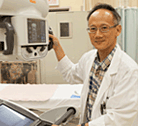Diagnostics
DRX-Revolution powers up at St. Michael’s
October 8, 2014

TORONTO – In January, St. Michael’s Hospital – downtown Toronto’s key trauma centre – began using the CARESTREAM DRX-Revolution Mobile X-ray System, a digital radiography mobile unit intended as a replacement for its CR portables in the emergency department. “We purchased two units – one to use in the trauma department and one to have as a spare,” said Terry Tang Poy (pictured), Operations Leader, Quality Control, St. Michael’s Hospital.
The DRX-Revolution is the result of a desire to improve point-of-care, bedside imaging. “It’s our entrance into mobile digital imaging and the first mobile designed with DR workflow in mind,” said Jimmy Ogle, a trained radiographer, and growth programs manager, Global X-ray Systems at Carestream (www.carestream.com). “Our intent was to do something different, and to improve bedside imaging.”
A powerful dual motor drive enhances maneuverability, making it easy to move through crowded hallways and elevators, as well as through tight spaces like patient rooms. It also has an industry-first automatic collapsible column that shrinks the system to just over 4-feet.
These features remedy the problems that hospital staff have experienced with other mobile systems – fatigue from pushing portable units through hallways and rooms, and an inability to see over the equipment while navigating through the facility.
At the patient bedside, DRX-Revolution powers up in less than five seconds and is ready to use with a single badge swipe. It’s said to provide consistent, precise images resulting in fewer retakes and faster, more accurate diagnosis.
Tang Poy says DRX-Revolution fits the workflow for the trauma department. These are patients involved in motor vehicle accidents, or gun related incidents where moving a patient increases the risk of further injury.
“When patients come into trauma we have very little information about them. But being able to image them immediately at the bedside, and to have results within five seconds – it saves valuable time, and many steps.”
Key features include:
- Tube and Line Visualization software – creates a companion image instantly verifying correct placement of gastric tubes, feeding tubes and central catheters;
- Rapid Image Display – if the first image taken is unclear, a second image can be taken with minimal detector repositioning;
- Pediatric Software Package – optimizes image quality by using pediatric-specific views, image acquisition techniques and processing parameters that suppress noise and enhance detail, all based on a patient’s size and weight
- Dual touch-screen monitor interfaces – speeds workflow and keeps technologists close to the patient.
Described as a radiology suite-on-wheels, it has everything a technologist needs in one place – even bins for gloves, batteries and detector bags. “We were very surprised by its productivity,” said Tang Poy. “When using CR portables, there’s a delay of five to 10 minutes after taking an X-ray due to travel time back to radiology, and processing the image.”
“Now the patient is imaged at the bedside in seconds, and we can access the RIS wirelessly – tracking images from beginning to end.”
The DRX-Revolution also plays an important role in the OR, where surgeons are checking the exact position of central catheters and gastric tubes. “The system shows doctors the image on-site, saving five to 10-minutes over CR portables,” said Tang Poy. “It powers up quickly and can process the image in seconds.”
Moreover, it uses half the required dose of a CR portable with a more precise image. “To see it in action, we were really surprised.”
The result: The DRX-Revolution has eliminated the need for two of SMH’s seven analog machines and CR usage has dropped. At the same time, there’s been a significant increase in productivity. “One DRX-Revolution portable does 80-85 percent of all exams. So two machines can completely eliminate the need for all our CR portables,” said Tang Poy.
SMH hopes to acquire funding for an additional unit. “The whole experience has been very positive,” said Tang Poy. “Moreover, the techs find it easy to use, and the (graphical) user interface is similar to what we already have, so the familiarity made training minimal.”
